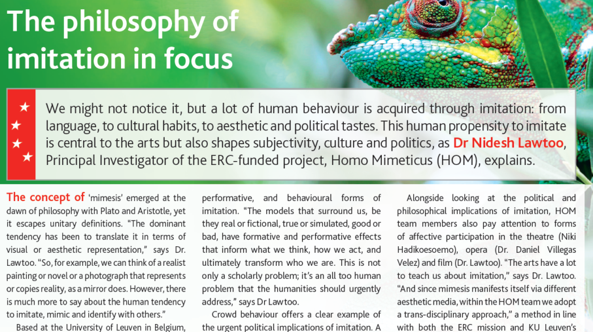In this 5th biannual Girard lecture, organized by the Dutch Girard Society, Nidesh Lawtoo steps back to the insights that, as of 2016, lead him to use the term “(new) fascism” as a warning against Donald Trump’s anti-democratic tendencies, which culminated in an insurrection on January 6. Despite many critical warnings and fascist actions, the efficacy of the affective and infective powers of mimesis never ceases to surprise. Hence, the urgency of new mimetic studies. More information HERE.
Tag Archives: (new) fascism
The Patho-Logies of Exclusion: Politics, Media, New Fascism

In this chapter based on the Raymond Schwager Lecture Nidesh Lawtoo delivered at the University of Innsbruck in 2019, he revisits his work on (new) fascism from the angle of the patho-logies of exclusions that turn mimesis into pathological scapegoating mechanism directed against minorities and immigrants. Chapter available HERE.
The Insurrection Moment: Insurrection, Conspiracy, Assault

In this HOM piece for a Theory & Event special issue on the Storming of the Capitol on January 6, Nidesh Lawtoo furthers mimetic studies by discussing the role of Dionysian intoxications, conspiracy theories, and dispossession in the company of Nietzsche, Deleuze and Black Mirror. Article available OA here
The Human Chameleon: Zelig, Nietzsche, and the Banality of Evil

In this OA article for Film-Philosophy Nidesh Lawtoo revisits the case of Woody Allen’s mockumentary Zelig (1983) via Nietzsche’s diagnostic of mimicry and Arendt’s analysis of the banality of eivl. It argues that the case of the “human chameleon” remains contemporary for both philosophical and political reasons for it reveals the centrality of mirroring reflexes in the rise of old and new fascisms.
Lawrence contra (New) Fascism
Part of a conference on D. H. Lawrence and the Demos, HOM PI Nidesh Lawtoo situates Lawrence’s critique of crowd psychology, the mimetic unconscious, and fascist contagion in the political novels. The background of the Black Forest provides reflections on Lawrence’s attention to the attraction and repulsion generated by “blood consciousness” or “root consciousness.” In the process, Lawrence turns out to be a key ally to fight contra (new) fascism in general and contra what Foucault calls the “fascism in us all.” Full article here.
Storming the Capitol: The Predictable Efficacy of (Hyper)Mimesis

How could a mimetic crowd go so easily from a conspiracy theory to a (new) fascist insurrection? In this piece for TCC Nidesh Lawtoo argues that what is surprising is not that the crowd hit the U.S. Capitol like a wave, but that no one in power saw this announced wave coming. If it is still unclear how (hyper)mimesis goes from conspiracy theory to (new) fascist actions, find out more here. Versione intervista in italiano per il CdT (con Carlo Silini): L’Assalto al Campidoglio.For related events on the importance to counter (new) fascism see also, Settima Lettera on Freud, Fascism, & Myth (March-June 2021); New Fascism & the Mimetic Unconscious (KU Leuven, Marc 24 ) New Fascisms, New Resistances (U Beragmo, 22-23 April)
The Case of Eichmann Restaged: Arendt, Evil, and the Complexity of Mimesis

In The Case of Eichmann Restaged, Nidesh Lawtoo reframes Hannah Arendt’s evaluation of the “banality of evil” in light of Eichmann’s mimetic psychology, which Arendt intuited but did not fully articulate.
Rather than considering the banality of evil as symptomatic of Eichmann’s “inability to think,” the essay foregrounds the affective, contagious, and, in this sense, mimetic tendencies at play in Eichmann’s personality (from Latin, persona, theatrical mask). This move is instrumental to articulate a middle path between Arendt’s theoretical diagnostic of Eichmann as “terrifyingly normal” and Bettina Stangneth’s recent historical account of Eichmann as a “fanatical National Socialist.” My wager is that the ancient problematic of mimēsis (from Greek, mimos, mime) casts a new and original light on the psychic foundations of a type of evil that is as relevant to understand the psychology of fascism in the past century as its rising shadow in the present century. Article also available here
New Article on TV Satire and Comic Fascism
We all know that TV satirical news shows play an essential role in unmasking political lies, promoting critical thinking, and fighting for free speech in an age under the spell of (new) fascist leaders. But did you know that by focusing so much media attention on apprentice presidents the same comics might also paradoxically (and against their best intentions) play in favor of the comic fascism they critique? If you read this article, you will know.

Book launch of (New) Fascism (2019)
In conversation with Wojciech Kaftanski, Nidesh Lawtoo presents his last book, (New) Fascism (MSU P 2019) at the Institute of Philosophy (Husserl Archives, KU Leuven, October 2019). A diagnostic of crowd behavior, mythic identifications, and mimetic contagion constitutive of the growing shadow of fascism.
EU Research Interview: The Philosophy of Imitation in Focus
In this interview with EU Research, Nidesh Lawtoo explains the main aspects of the HOM project by outlining, in broad and accessible strokes, the good and bad effects of unconscious mimesis investigated by the HOM team in areas as diverse as philosophy, the arts, and politics. He argues that the power of mimesis to transform subjectivity is “not only a scholarly problem, but a human, all too human problem.” Full interview available here. 
